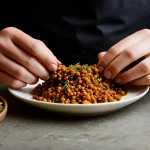Essential Ingredients for a Traditional Steak and Kidney Pie
The foundation of a traditional steak and kidney pie lies in selecting the right steak and kidney pie ingredients to achieve that authentic flavour and texture. The must-have components begin with quality cuts of beef, commonly chuck or braising steak, known for their tenderness and ability to develop rich taste when slow-cooked. Alongside, the choice of kidney profoundly influences the pie’s character; beef kidney is classic for robust flavour, while lamb or pork kidney offers a milder alternative.
Freshness and quality of these ingredients are indispensable; fresh steak and kidney ensure the pie’s integrity and an unrivalled mouthfeel. Avoiding frozen or overly processed cuts preserves tenderness and the natural juices, contributing to the pie’s moist and hearty filling.
Topic to read : How Do Cultural Influences Shape UK Cooking Today?
Equally crucial are the seasoning and aromatic blends, which provide depth to the pie. Traditional seasoning uses salt and black pepper as essentials, with herbs like thyme and bay leaves layered for subtle earthiness. Onions usually accompany the filling, enhancing sweetness and balancing the robust flavours. These classic aromatics meld with a rich stock or gravy, making the pie filling succulent and flavourful.
In essence, the marriage of premium steak and kidney pie ingredients—carefully chosen meats and nuanced seasonings—forms the cornerstone of an authentic, memorable traditional pie.
In the same genre : How can you recreate a traditional full English breakfast at home?
Selecting the Best Cuts of Steak and Kidney
Choosing the best steak for pie is crucial for a tender and flavourful traditional pie. Cuts from the shoulder or chuck, such as braising steak, are preferred due to their marbling and connective tissue that break down during slow cooking, developing a rich texture. Avoid lean cuts that can dry out, undermining the filling’s juiciness.
When it comes to kidney, three main types stand out: beef, lamb, and pork. Beef kidney is prized for its full-bodied flavour, adding depth to the pie. Lamb kidney offers a milder, sweeter alternative suitable for those sensitive to stronger tastes. Pork kidney is less common but delivers a subtle earthiness, balancing robust beef flavours. Selecting the right type significantly influences the pie’s character, from taste intensity to mouthfeel.
How does ingredient selection affect texture? Including well-marbled beef adds succulence, while fresh kidney contributes a distinct chew and flavour that can either dominate or complement the meat’s richness based on type. Precise cuts and freshness are must-have components ensuring a perfect steak and kidney pie filling that satisfies traditional palates.
Seasonings and Additional Components for Depth of Flavour
The perfect steak and kidney pie seasonings balance enhances the filling’s richness without overwhelming its core ingredients. Classic seasoning choices include salt and freshly ground black pepper, foundational to bringing out the natural flavours of beef and kidney. Herbs such as thyme and bay leaves are traditional components, offering subtle earthiness and aromatic complexity that develop during slow cooking.
Adding aromatics like onions is standard, introducing sweetness and depth that complement the robust meats. Some recipes incorporate garlic or a touch of Worcestershire sauce to heighten savoury notes, but these remain optional to keep the focus on traditional flavours.
A rich, well-made stock or gravy is vital among the must-have components for a moist, succulent pie filling. Beef stock, simmered with herbs and the meat’s juices, produces a luscious base that binds the filling and intensifies taste. The gravy should be thick enough to cling to the meat yet not overly heavy, preserving the classic texture.
Including optional vegetables like finely diced carrots or mushrooms can add texture and flavour complexity but should be used sparingly to retain authenticity. Ultimately, the proper blend of steak and kidney pie seasonings, aromatics, and stock unlocks a classic, deeply satisfying traditional pie.
Role of Pastry in Achieving the Perfect Pie
Choosing the right pie pastry is a critical must-have component for a truly authentic steak and kidney pie. Traditional recipes often call for either shortcrust or puff pastry, each lending a distinct texture and flavour. Shortcrust pastry offers a firm, crumbly base that holds the rich filling well, providing a satisfying contrast to the tender meat and kidney. Puff pastry, on the other hand, imparts a light, flaky, golden crust that adds an elegant crunch and visual appeal.
What makes a good steak and kidney pie crust? It should be sturdy enough to contain the filling without becoming soggy, yet delicate enough to melt in the mouth. Achieving this balance depends on proper ingredient ratios—cold butter, minimal handling, and correct baking temperatures are essential techniques whether using shortcrust or puff.
For preparation, refrigeration of the pastry before baking helps maintain its structure. Some bakers prefer to blind bake the base slightly for shortcrust to prevent a soggy bottom. Sourcing quality ingredients such as pure butter and high-protein flour enhances the pastry’s flavour and texture.
Ultimately, the pie pastry choice and preparation elevate the entire pie experience, complementing the hearty filling with the perfect crust texture and taste.
Ingredient Variations and Customisation for Personal Preference
When exploring steak and kidney pie variations, understanding the available ingredient alternatives can help tailor the pie to individual tastes and dietary preferences. While beef steak and kidney form the traditional base, substituting cuts like diced lamb or venison provides a gamey twist, accommodating those seeking new flavour profiles. Similarly, swapping kidneys from beef to lamb or pork introduces varying degrees of richness and intensity, altering the filling’s character without compromising authenticity.
Regional ingredient adaptations often reflect local availability and culinary influences. For example, some custome pie recipes include mushrooms or even black pudding to add texture and complexity. These modifications remain sensitive to the pie’s traditional foundation yet allow personalised upgrades.
Maintaining quality in substitutions is critical. Freshness and correct cut selection—whether choosing alternative steak types or kidney—remain must-have components to preserve the pie’s tender texture and bold flavours. Flourishing in flavour hinges on these choices. This flexibility encourages cooks to experiment while respecting the classic essence of a traditional pie. Thus, thoughtful ingredient alternatives empower customisation while upholding the pie’s spirit.









